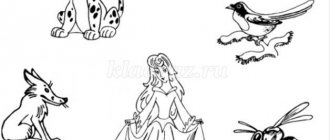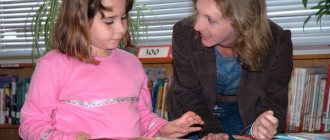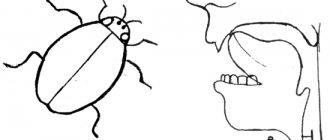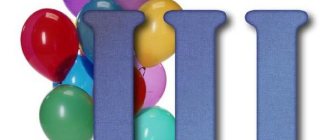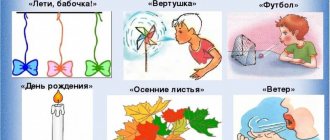Summary of an individual speech therapy lesson on the topic: “Producing the sound C”
Individual speech therapy session
Subject:
Setting sound [C].
Goals:
Staging and automation of sound [C]. Fixing sounds in isolated positions, in syllables, in words and sentences. Production of whistling sounds, their differentiation.
Tasks:
Educational:
Setting and assigning the phoneme [C] in reflected repetition to the teacher, independently.
Enrichment of the dictionary.
Corrective:
Formation of syllabic analysis skills.
Fixing the sound [S] in isolation, in syllables, words, sentences.
Development of thinking, memory, attention.
Development of phonetic hearing.
Development of motor skills of articulation organs and fingers.
Educational:
Maintaining interest in learning and working with a speech therapist.
Cultivating hard work.
Developing the skill of controlling sound pronunciation. Equipment
To conduct the lesson in a fun way, you will need a toy (for example, a bear, an elephant), a mirror, pictures of articulation exercises, a sound ruler, cards with letters and images of objects, and syllable diagrams.
Progress of the lesson
1.Organizational moment
- Good afternoon, ... (child's name). Today we will meet a guest. He came to us to see what you were doing in class, to help you do exercises and play.
- Come on, let's meet him. The elephant's name is Semyon. How are you?
“We’ve met, now let’s tell the elephant what we’re going to do today.”
— Let’s learn how to pronounce the sound [C] correctly, and repeat exercises to warm up the face, fingers, and tongue. Let's look at interesting pictures from fairy tales and come up with our own story. And Semyon will help us and learn too. What sound does the elephant's name begin with? (child answers), what’s your name? (Well done.)
2. Game “Hear and Clap”
Goal: to develop phonemic awareness.
- Let's play a game. I will name the words, and you will clap your hands if you hear the sound [C].
Sleigh, broom, elephant, owl, cat, bag.
- Well done. The elephant praises you too. He is proud of you, wants to be just as smart and attentive.
- Now let's get ready to warm up.
3.Articulation gymnastics
(To produce the sound [C], articulatory gymnastics must be used. Completing tasks helps to relax the muscles, feel the position of the organs of the oral cavity, and set them up for work. This stage cannot be excluded from the speech therapy session.)
Massage:
- Repeat the steps after me. Rub your palms and fingers. Stroke yourself on the cheeks, forehead (3-4 times). Move your hands to your ears, rub the earlobes (3-4 times). Rub over the lips, under the chin (3-4 times).
Articulation exercises:
(Performed in front of a mirror or without it, the child repeats the movements after the teacher.)
*Smile
We stretch the sponges as far as possible to the sides. We hold the smile for a few seconds, then relax the muscles. 2-3 repetitions.
*Spatula
We smile, open our mouth, and place our tongue on our lower teeth. We slap our tongue on our lips and say: “Bya, five, five, bya.”
*Jam
We lick our lips as if they were smeared with a sweet treat.
*Needle
Stick out your sharp tongue, pull it out as far as possible, and now hide it back. Repeat.
- Well done. Our tongue and lips are ready for the lesson.
4. Breathing exercises
(Helps the child relax, take a break from articulations, and get ready for further work. Perform 2-3 breathing exercises.)
· Puffing out our cheeks
-Come on, let's make Semyon laugh. Let's show him how a fish breathes underwater. Take air into your mouth and puff out your cheeks. Try not to release it right away, hold it. Then puff up one cheek, then the other.
*Trumpeter
- Pull your sponges into a tube. Take air into your lungs and blow it out through a thin slit in your mouth, as if you were blowing out a candle.
5.Finger gymnastics
- Now let’s stretch our fingers. Let's make a “Lock”, “Ring Fist”.
6.Sound production
1) Main part of the lesson
(The production of the sound [C] is carried out using a mirror. The child must follow the movements of the articulatory apparatus. Fix the correct positions of the lips and tongue. These exercises and methods can be used as methods for producing whistling sounds in the following lessons.)
— First, let’s tell the elephant how we pronounce the sound [S]. Show what the tongue, lips, teeth do, how the air passes. Let's remember together.
- Put your lips together in a smile, clench your teeth, relax your tongue and place it at the bottom of your mouth. Its tip should rest against the lower teeth. Exhale into your palm. Do you feel the cold air coming out in a thin stream?
- Well done. Let's do it again.
- Remember that the consonant C can be hard and soft, it is always unvoiced. Can you name a few words where C is soft.
- I call the word Syoma. Try to come up with it.
- And now words where C is hard. I call the word, dream. It's your turn.
- Let's look at the pictures. They depict fruits. Name those that begin with S.
(The child is offered color images: plum, pineapple, currant, cucumber, tomato, peach, etc.
“Now let’s talk for a long, long time.” Ssssssss. Let's sing a song to Semyon, as if we were inflating the tires with a pump. S-S-S.
The production of the C sound in dysarthria is accompanied by vowel sounds. We pronounce the syllables su, sa, then the small words soup, dog. We sing not a separate phoneme, but syllables with vowels.
(The placement of the sound C is similar to the correction of the pronunciation of the phoneme Ш. The tongue takes the same position, the lips stretch to the sides.)
Mechanical method
If the student cannot cope with pronunciation on his own, use the production of the sound C with the help of a teacher and a spatula, toothpick, and fingers. The mechanical method of extracting a phoneme helps the child feel. Understand the correct positions of the cheeks and tongue, control the process of exhaling air during articulation.
Sound production:
1. Place the stick on the child’s tongue. It is immersed in the oral cavity by 1.5 - 2 cm.
2. The child forms a groove on his elongated tongue and blows air along it. You can press on the stick, lowering your tongue to the lower palate. We will hear whistling sounds when exhaling.
3. Place the tongue and stick in different positions, look for the desired position for the most clear phonation.
Sound Automation
Sound automation needs to be given special attention. This stage of work is important for consolidating the norms of sound pronunciation in free speech. We automate sound in syllables, words, sentences, stories.
To automate the sound [S], syllable patterns will be required. The sound [S] should be hard, soft, and in different positions. After pronunciation, an analysis of the pairs is required, comparing them by sound and meaning.
*in syllables
- Come on, let’s read the cards with you. Repeat after me, look in the mirror at the movements of your lips and tongue. Tighten them up.
Sa-sa-sa - what a beauty. Si-si-si, don't miss it. Se-se-se, don’t go to your place.
The set of syllables may differ from the one given; use open, closed isolated syllables to set the sound s; use the same cards, phonemic sets to reinforce the sound [Ш].
in words
- Now let's move on to the words. Pronounce it correctly, don't rush.
Automation of the sound [S] in words at the end, in the middle, at the beginning of a word.
- Look at the cards. What is shown in the pictures?
in sentences
You can use plot pictures from books and collections of fairy tales. The child is asked to repeat sentences and phrases after the teacher. Then compose your own text based on the proposed vocabulary
in
the texts
- Look at the picture. What do you see?
- This is Boris and Slava. The boys gathered in the forest. I'll tell you about them, and you repeat them.
Slava and Boris gathered in the forest. They want to see the pine trees and listen to the nightingale sing. They took their dog Strelka with them.
(The child repeats the story. Correct violations in sound pronunciation. Fix attention on the problematic sound.
- Now come up with a short story about our guest, the elephant Semyon. I will offer you a few words to use in the text: elephant, scooter and pump. (A few minutes are given to think about it if desired. The text is compiled. The teacher monitors phonetics, grammar, syntax.)
· Crossword
— Do you like to solve crosswords? I have prepared a crossword puzzle for you with words with the sound [S]. Try to guess it.
Lesson summary
- Today you and I learned a lot of new things, we learned to pronounce the sound [S] better. Say it again. Well done!
-At home, repeat the tongue twisters: “Robin Bobbin eats all day, and he is not too lazy to chew. He ate a whole apricot, he began to peel the coconut,” “Took Sanya with him to the sleigh hill,” “Mow, scythe, while the dew is on.”
-Let's say goodbye to Semyon and invite him to the next lesson.
Disturbances in the reproduction of C and C
Speech therapists here
Defects are divided into 2 groups:
- Sigmatism (distorted reproduction). This includes types of violations:
-
labiodental
. The sounds “S” and “S” are replaced with the phoneme “F” (Son - Background, Owl - Fova); - interdental.
When playing, the tip of the tongue is between the teeth.
The child has a lisp when pronouncing words
; - side.
The tongue falls to one side when pronouncing a sound; - nasal.
It is observed in children with anatomical and physiological defects (rhinolalia, rhinophonia).
2. Parasigmatism (the sound “S” is replaced by other letters). Kinds:
- dental
Replacing “S” with “T” and “S” with “Th” (Son - Tone, Blue - Tiny); - hissing.
“S” and “S” to “Sh” to “Shch” (Light - Shvet - Shvet); - mitigation errors. The hard
“S” is replaced by “S” (Dog - Syabaka); - defects of deafness and voicedness.
“S” and “S” to “Z” and “Z” (Snow - Zneg).
Violations lead to defects in sound pronunciation (dyslalia)
. The child may also develop problems with reading (dyslexia) and have difficulties in writing speech (dysgraphia here).
Articulation gymnastics for whistling sounds
1. Lip exercises.
- “Smile” - stretch your lips into a smile as much as possible. The teeth should be closed. Hold your lips in this position for several seconds. Repeat several times.
- “Tube” - the teeth are closed, the lips are pulled forward.
2. An exercise to develop an air stream - be able to forcefully blow air through your lips, folded into a tube. The air stream should be sharp and cold. Repeat several times.
- “Football” - you need to take a small piece of cotton wool. This will be the ball. Set up an improvised gate. The child must blow forcefully on the cotton wool and try to score a goal. Monitor the direction of the air stream. She should be strong, cold, lips like a tube.
3. Exercises for the tongue.
- “Let’s brush your lower teeth” - smile, open your mouth slightly, use the tip of your tongue to “brush” your lower teeth from the inside, moving your tongue from side to side.
How to consolidate the results of classes
To achieve the desired result, you should work with a speech therapist on an ongoing basis. It is strongly recommended not to quit classes at the first improvement in pronunciation. Sound fixation is carried out through automation. This process involves the use of individual sounds when pronouncing syllables, phrases and sentences. During classes with a speech therapist, you are given tasks that help improve your speaking skills. The automation stage is considered the most difficult. Activities help develop speaking skills and introduce learned sounds into everyday speech. The main task of parents is to facilitate the process by prompting and helping the child.
The most effective way to consolidate results is to read aloud. At the initial stages, you can pronounce simple tongue twisters. In the future, you need to move on to more voluminous texts. It is important to maintain a conversation with your baby. This not only trains speech, but also develops hearing.
For dysarthria in children, physiotherapy, drug treatment and speech therapy massage are used in combination with exercises. Dysarthria develops in 3-6% of cases. It is accompanied by increased tone and excessive tension in the muscles of the articulatory organs. A specific feature of the disease is the difficulty of overcoming defects. Therefore, the process of speech restoration takes much more time.
